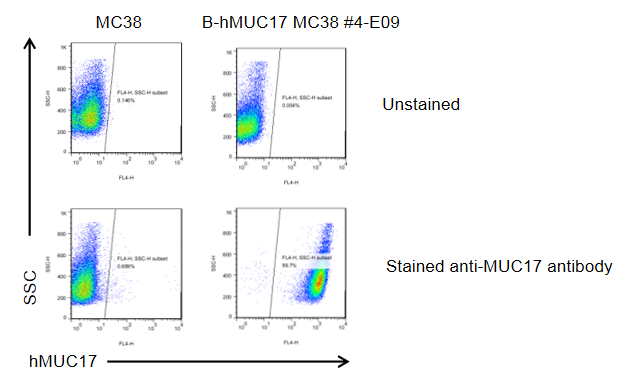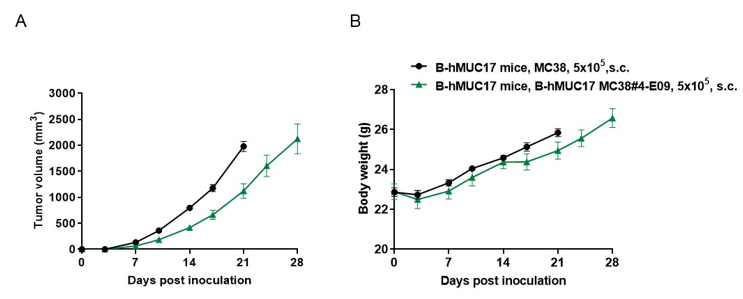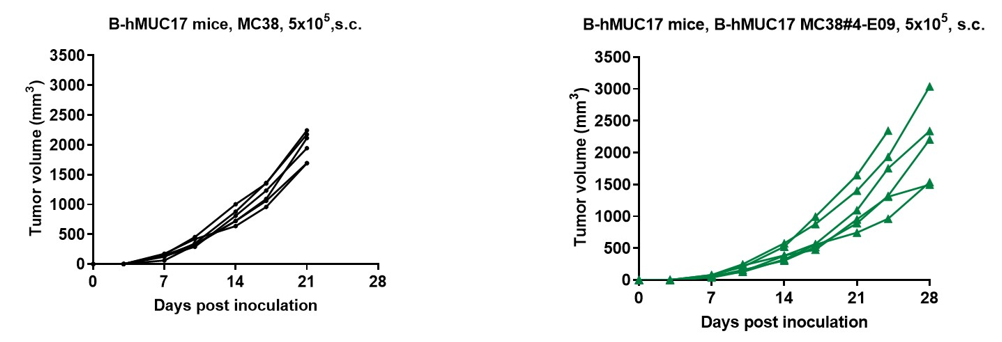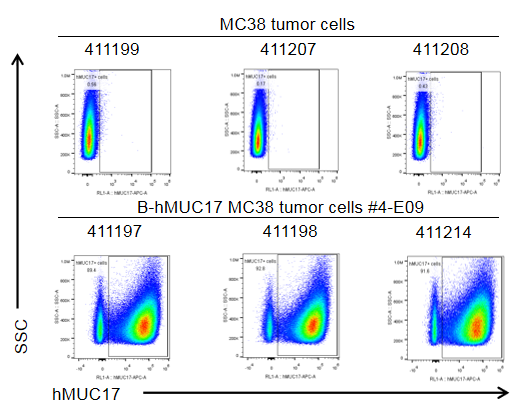B-hMUC17 MC38
|
Common name |
B-hMUC17 MC38 | Catalog number | 321918 |
| Aliases |
MUC17, MUC-17, MUC-3, MUC3, mucin 17, cell surface associated |
Disease | Colon carcinoma |
|
Organism |
Mouse |
Strain | C57BL/6 |
| Tissue types | Colon | Tissue | Colon |
Gene targeting strategy for B-hMUC17 MC38 cells. The expression cassettes containing the exogenous promoter, mouse Muc3 signal peptide,a truncated PTS domain with 3 out of 60 tandem repeats, followed by the full-length epidemal growth factor-like domain, SEA domain, transmembrane domain and cytoplasmic tail domain of human MUC17 was inserted to replace part of murine Muc3 exon 4 and all of exon 5-11. The insertion disrupts the endogenous murine Muc3 gene, resulting in a non-functional transcript.

MUC17 expression analysis in B-hMUC17 MC38 cells by flow cytometry. Single cell suspensions from wild-type MC38 and B-hMUC17 MC38 cultures were stained with species-specific anti-MUC17 antibody. Human MUC17 was detected on the surface of B-hMUC17 MC38 cells but not wild-type MC38 cells. The 4-E09 clone of B-hMUC17 MC38 cells was used for in vivo tumor growth assays.

Subcutaneous homograft tumor growth of B-hMUC17 MC38 cells. B-hMUC17 MC38 cells (5x105) and wild-type MC38 cells (5x105) were subcutaneously implanted into heterozygous B-hMUC17 mice (Male, 8-week-old, n=6). Tumor volume and body weight were measured twice a week. (A) Average tumor volume ± SEM. (B) Body weight (Mean ± SEM). Volume was expressed in mm3 using the formula: V=0.5 X long diameter X short diameter2. As shown in panel A, B-hMUC17 MC38 cells were able to form tumors in vivo and can be used for efficacy studies.

B-hMUC17 MC38 tumor cells growth of individual mice. B-hMUC17 MC38 cells (5x105) and wild-type MC38 cells (5x105) were subcutaneously implanted into heterozygous B-hMUC17 mice (Male, 8-week-old, n=6). As shown in panel, B-hMUC17 MC38 cells were able to establish tumors in vivo and can be used for efficacy studies.

B-hMUC17 MC38 cells were subcutaneously transplanted into heterozygous B-hMUC17 mice (n=6), and on 28 days post inoculation, tumor cells were harvested and assessed for human MUC17 expression by flow cytometry. As shown, human MUC17 was highly expressed on the surface of tumor cells. Therefore, B-hMUC17 MC38 cells can be used for in vivo efficacy studies of MUC17 therapeutics.











